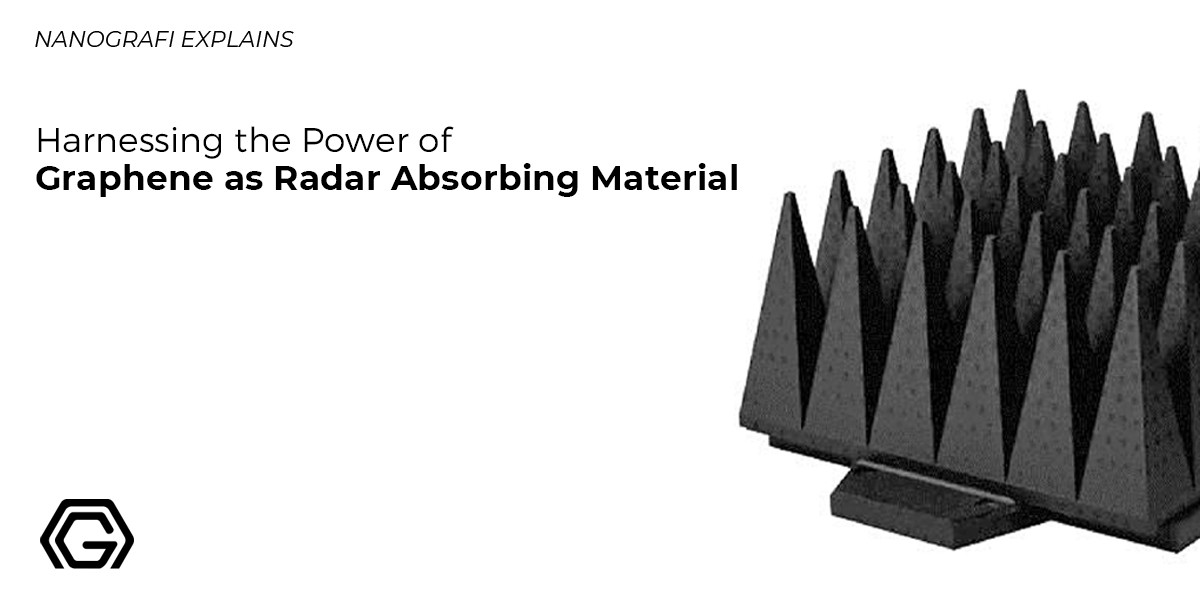Harnessing the Power of Graphene as Radar Absorbing Material- Nanografi
The remarkable properties and superior performance of graphene render it an promising radar absorbing material, captivating the interest of researchers and creating a compelling urge to delve into its potential applications.
Graphene, a single-atom-thick material composed of carbon atoms, exhibits unique electrical,mechanical, and thermal properties. When employed as a radar absorbing material, it garners significant interest due to its high performance and impressive characteristics. Graphene's radar absorption capabilities stem from its ability to minimize the reflection of electromagnetic waves by absorbing them. With its low density, wideband absorption, excellent conductivity, and effectiveness across a broad frequency range, graphene offers advantages in reducing reflections and associated reflection losses in radar systems. At Nanografi, our advanced manufacturing processes and expertise allow us to deliver graphene with exceptional properties. To discover further information about graphene products, you can visit Nanografi.
Introduction
Graphene exhibits high conductivity and broadband absorption properties, as well as the ability to interact with microwaves and reduce reflections, making it a promising material for microwave applications in communications and radar technologies. These microwaves cover wavelengths from one square millimeter to one meter. The use of resistive and metallic surfaces for microwave absorption and free-space steering, respectively, poses challenges for active microwave management due to the need for large adaptive surfaces. Extensive research aims to achieve electrically controllable microwave reflection and transmission, focusing primarily on tuning microwave-matter interactions by electrical methods.
Adaptive surfaces use materials with variable conductivity, permittivity or permeability. Our proposal proposes to manipulate surface charge concentration instead of bulk material properties to control microwaves. Graphene, a 2D carbon crystal with an extremely large surface area, provides a promising platform for innovative adaptive microwave surfaces. Through electrostatic doping, atomically thin layers enable the realization of transformable radar absorption surfaces.
What is Radar-Absorbing Material (RAM)?
Radar-absorbing materials (RAM) are specifically designed materials that are used to reduce or eliminate the reflection of electromagnetic waves. They employ two main approaches:
- Absorption
- Multiple reflections.
In the absorption process, RAM is able to absorb electromagnetic waves that come into contact with it. This absorption reduces the intensity of the waves and converts them into heat energy. RAM achieves this through different mechanisms such as ohmic loss, dielectric loss, or magnetic loss, which are influenced by the material's permeability and complex permittivity.
Multiple reflections, also known as destructive interference, occur within the RAM when incoming waves are reflected back and forth between the rear and front faces of the material. This phenomenon helps to minimize the overall reflection of the waves.
RAM plays a crucial role in stealth technology, particularly in reducing the radar cross-section of military aircraft and unmanned aerial vehicles (UAVs). It is applied to various surfaces, including the exterior skin and high-radar reflection areas like surface edges, in order to weaken reflected signals by absorbing the electromagnetic wave energy.
Applications of Radar Absorbing Materials
The utilization of radar-absorbing materials (RAM) and structures in stealth technology, such as the application of these materials on the surfaces of the F-117 Nighthawk aircraft by the United States Air Force, represents one of the most well-known applications of RAM. However, it is important to note that RAS (Radar Absorbing Structures) and RAM find applications not only in the military field but also in commercial microwave communications systems. In recent years, RAM has also been employed in commercial and civil settings to mitigate radar scattering from large buildings located near airports, which could potentially interfere with civil aviation radar systems. Moreover, RAM is utilized in various consumer electronics such as antennas, automobile radios, mobile phones, and telecommunications base stations.
Types of Radar Absorbing Materials
Radar-absorbing materials (RAM) encompass a range of absorbers designed to minimize the reflection of electromagnetic waves. These absorbers play a crucial role in enhancing stealth capabilities by reducing radar wave reflection.
- Foam Absorbers: Foam absorbers, such as carbon-loaded sheets and shaped foam absorbers, come in different forms and are used to minimize reflection in anechoic chambers.
- Elastomers: Elastomers are used as surface wave absorbers, while iron ball paint contains iron particles that convert radar energy into heat through molecular oscillations.
- Iron Ball Paint: Iron ball paint, which contains iron particles, reduces reflection by converting radar energy into heat through molecular oscillations.
- Low-frequency Absorbers: Low-frequency absorbers utilize shaped magnetic particles to achieve effective reflection loss.
- Jaumann Absorbers: Jaumann absorbers work on the principle of wave interference to cancel reflected signals.
- Tuned Frequency Absorbers: Tuned frequency absorbers exhibit considerable reflection loss at specific frequencies.
- Cavity Resonance Absorbers: Cavity resonance absorbers are designed for high loss in microwave cavities.
- Split-ring Resonators (SRRs): SRRs have shown excellent performance as radar absorbers. These technologies can be combined to enhance absorption capabilities.
Electromagnetic Principles of Radar Absorbent Materials
Microwave radiation reflection control is crucial in various scenarios. For example, anechoic chambers, which aim to simulate free space in a confined environment, require walls lined with materials that absorb electromagnetic waves. Similarly, in surveillance radar systems, powerful return signals from nearby objects like masts, buildings, or bridges can limit performance. Coating these objects with absorbent layers can enhance radar system capabilities. Japan is addressing television "ghost pictures" caused by signal reflections using a similar approach. The military has also recognized the potential of microwave-absorbing materials, such as those used in the "Stealth" program, to reduce target detectability. Each application of radar absorbent materials has unique electromagnetic requirements, with anechoic chambers requiring high absorption across a wide frequency range.
Designing absorbers involves considering factors like the environment, weight, size limitations, and the specific variables that affect performance. Geometrical variables are crucial due to the wavelength size at microwave frequencies, and absorbers rely on bulk electromagnetic properties. Practical electromagnetic absorbers must meet specific conditions and maintain their performance over the relevant frequency band throughout their operational life. This multidisciplinary field encompasses knowledge of electromagnetic properties, structural integrity, and chemical composition. Important electromagnetic fundamentals include material properties, reflection and refraction at boundaries, and impedance matching. By considering these aspects, effective control over microwave radiation reflection can be achieved in diverse environments and applications.
Graphene as Radar Absorbing Material
Graphene and its compounds, such as graphene oxide (GO) and reduced graphene oxide (rGO), have attracted significant interest as microwave absorber materials. Researchers have developed permeable hierarchical nanocomposites of CoFe2O4/rGO (CFO/rGO) using an in situ solvothermal method. The EM characteristics of the CFO/rGO composites were studied by varying the sample thickness and adjusting the weight % of rGO. The results showed an effective bandwidth of 5.8 GHz (8.3–14.1 GHz) and a microwave absorption reaction at 10 GHz. The improved impedance matching, dielectric loss, micropores in the CFO, and interfacial polarization contribute to the material's attenuation qualities. Similar research on FeCoNiOx and PDA-rGO composites demonstrated a maximum attenuation of 36.28 dB with a 3.2 GHz effective bandwidth and a 6.5 mm thickness. These materials primarily attenuate electromagnetic waves through dielectric deficit, while the magnetic metallic components enhance impedance matching and energy loss.
The Benefits of Graphene Included Radar Obserbing Material
Graphene, as a radar-absorbing material, offers a range of benefits due to its unique properties. Firstly, graphene exhibits exceptional electrical conductivity, allowing it to effectively absorb and dissipate electromagnetic waves. This results in reduced radar reflection and enhanced stealth capabilities. Additionally, graphene is lightweight and flexible, making it suitable for various applications, including coating surfaces of military aircraft and unmanned aerial vehicles (UAVs). Its thin and compact structure enables seamless integration into existing systems without compromising aerodynamics. Moreover, graphene-based radar-absorbing materials have the potential for wide bandwidth absorption, covering a broad range of frequencies. This versatility makes graphene a promising candidate for next-generation radar-absorbing materials, providing improved performance and efficiency in radar systems. Overall, the benefits of graphene as a radar-absorbing material lie in its high conductivity, lightweight nature, compatibility with existing systems, and broad frequency absorption capabilities.
Graphene and Carbon Nanotube-based Composite Materials Properties for RAM
Graphene and carbon nanotube-based composite materials have garnered significant attention for their potential in radar-absorbing materials (RAM). These composites offer unique properties that make them suitable for RAM applications, such as exceptional electrical conductivity, mechanical strength, and flexibility. By combining graphene and carbon nanotubes, researchers aim to enhance the radar-absorbing capabilities of the composite, reducing the reflection of electromagnetic waves and improving stealth capabilities. Further research is needed to optimize the composition and structure of these composites and develop selection criteria for their specific purposes.
Carbon nanomaterials, including fullerene, carbon nanotubes, and graphene, hold great potential for next-generation memory and storage systems due to their remarkable electrical, mechanical, and thermal characteristics. Research is underway to explore their applications in resistive-switching media, interfacial engineering layers, memory electrodes, and high-performance memory selectors. Despite the challenges associated with producing and incorporating these materials, their potential benefits in terms of bit concentration and energy efficiency in non-volatile memory systems are being investigated.
Conclusion
Graphene's remarkable properties and performance make it a promising radar-absorbing material. Its unique electrical conductivity, mechanical strength, and thermal properties contribute to its effectiveness in reducing reflections and associated losses in radar systems. Combining graphene with carbon nanotubes in composite materials further enhances radar absorption capabilities. Optimizing the composition and structure of these composites holds potential for improved stealth capabilities. Further research is needed to explore their specific applications and meet the diverse requirements of radar-absorbing materials. The use of graphene and carbon nanotube-based materials shows promise for advancing radar technologies in the future.
By harnessing state-of-the-art technologies and employing top-notch materials, Nanografi revolutionizes your projects and propels your business to new frontiers. Embrace Nanografi products to unlock boundless possibilities and achieve unparalleled success.
References
Ahn, E. C., Wong, H. S. P., & Pop, E. (2018). Carbon nanomaterials for non-volatile memories. Nature Reviews Materials 2018 3:3, 3(3), 1–15. https://doi.org/10.1038/natrevmats.2018.9
Aytaç, A., İpek, H., Aztekin, K., & Çanakçı, B. (2020). A review of the radar absorber material and structures. Scientific Journal of the Military University of Land Forces, 198(4), 931–946. https://doi.org/10.5604/01.3001.0014.6064
Balci, O., Polat, E. O., Kakenov, N., & Kocabas, C. (2015). Graphene-enabled electrically switchable radar-absorbing surfaces. Nature Communications 2015 6:1, 6(1), 1–10. https://doi.org/10.1038/ncomms7628
Baum, Z. J., Bird, R. E., Yu, X., & Ma, J. (2022). Lithium-Ion Battery Recycling─Overview of Techniques and Trends. ACS Energy Letters, 7(2), 712–719. https://doi.org/10.1021/ACSENERGYLETT.1C02602/ASSET/IMAGES/LARGE/NZ1C02602_0005.JPEG
Bird, R., Baum, Z. J., Yu, X., & Ma, J. (2022). The Regulatory Environment for Lithium-Ion Battery Recycling. ACS Energy Letters, 7(2), 736–740. https://doi.org/10.1021/ACSENERGYLETT.1C02724/ASSET/IMAGES/LARGE/NZ1C02724_0002.JPEG
Lederer, & G., P. (1986). An introduction to Radar Absorbent Materials (RAM). STIN, 87, 13594. https://ui.adsabs.harvard.edu/abs/1986STIN...8713594L/abstract
Ma, X., Azhari, L., & Wang, Y. (2021). Li-ion battery recycling challenges. Chem, 7(11), 2843–2847. https://doi.org/10.1016/J.CHEMPR.2021.09.013
Military Applications of Graphene - Nanografi Nano Technology. (n.d.). Retrieved March 26, 2024, from https://nanografi.com/blog/military-applications-of-graphene/
Radar Absorbing Materials Selection Guide: Types, Features, Applications | GlobalSpec. (n.d.-a). Retrieved March 26, 2024, from https://www.globalspec.com/learnmore/materials_chemicals_adhesives/electrical_optical_specialty_materials/radar_absorbing_materials_structures_ram_ras
Radar Absorbing Materials Selection Guide: Types, Features, Applications | GlobalSpec. (n.d.-b). Retrieved March 26, 2024, from https://www.globalspec.com/learnmore/materials_chemicals_adhesives/electrical_optical_specialty_materials/radar_absorbing_materials_structures_ram_ras
Radiation-absorbent material - Wikipedia. (n.d.). Retrieved March 26, 2024, from https://en.wikipedia.org/wiki/Radiation-absorbent_material#See_also
Ricci, A. ;, Cataldi, A. ;, Zara, S. ;, Gallorini, M., Ricci, A., Cataldi, A., Zara, S., & Gallorini, M. (2022). Graphene-Oxide-Enriched Biomaterials: A Focus on Osteo and Chondroinductive Properties and Immunomodulation. Materials 2022, Vol. 15, Page 2229, 15(6), 2229. https://doi.org/10.3390/MA15062229
Ruiz-Perez, F., López-Estrada, S. M., Tolentino-Hernández, R. V., & Caballero-Briones, F. (2022). Carbon-based radar absorbing materials: A critical review. Journal of Science: Advanced Materials and Devices, 7(3), 100454. https://doi.org/10.1016/J.JSAMD.2022.100454
Setua, D. K., Mordina, B., Srivastava, A. K., Roy, D., & Eswara Prasad, N. (2020). Carbon nanofibers-reinforced polymer nanocomposites as efficient microwave absorber. Fiber-Reinforced Nanocomposites: Fundamentals and Applications, 395–430. https://doi.org/10.1016/B978-0-12-819904-6.00018-9
Stealth technology - Wikipedia. (n.d.). Retrieved March 26, 2024, from https://en.wikipedia.org/wiki/Stealth_technology
The Future of Lithium-Ion Battery Applications - Nanografi Nano Technology. (n.d.). Retrieved March 26, 2024, from https://nanografi.com/blog/the-future-of-lithiumion-battery-applications/
This is why batteries are important for the energy transition | World Economic Forum. (n.d.). Retrieved March 26, 2024, from https://www.weforum.org/agenda/2021/09/batteries-lithium-ion-energy-storage-circular-economy/
Recent Posts
-
Advanced Materials for Unmanned Aerial Vehicle (UAV) Protection Against Laser
Consider a UAV on a critical mission, rendered inoperative by a sudden laser attack. With the increa …26th Jul 2024 -
Simulation and Modeling of Material Properties
Our world is composed of a dazzling array of materials, each with its own unique properties that dic …19th Jul 2024 -
Advanced Coatings for Superior Corrosion and Wear Resistance
Corrosion and wear pose significant challenges across various industries, leading to substantial eco …12th Jul 2024






